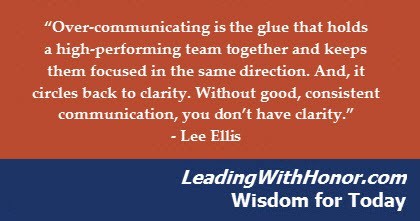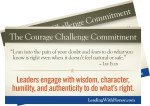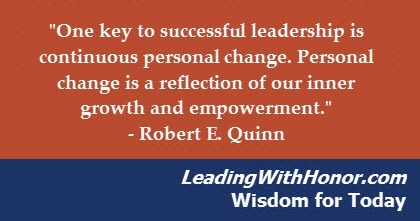Lee Ellis's Blog, page 291
November 8, 2015
On This Day in Leadership History, November 8, 2015
On this day in leadership history in 1956, after turning down 18,000 names, the Ford Motor Company decided to name their new car the “Edsel,” after Henry Ford’s only son. While it’s okay to exhaustive in searching for the perfect future plan for your work and leadership, don’t forget to have a plan that has a strong emotional connection with as much buy-in as possible. Take the time to build your plan for success!
Edsel – Wikipedia


November 6, 2015
Leading with Honor Wisdom for Today, November 6, 2015
“Over-communicating is the glue that holds a high-performing team together and keeps them focused in the same direction. And, it circles back to clarity. Without good, consistent communication, you don’t have clarity.” – Lee Ellis


November 5, 2015
Are American Millennials Among the World’s Least Skilled?
We hear about the superior tech savvy of people born after 1980 so often that we tend to assume it must be true. But is it? How do we respond as leaders that want to invest in competent people?
Check out this article from Fortune.com and share your comments –

BOULDER, CO – MAY 6: 27-year-old Alex Riegelman, a user experience designer, is part of the workforce at Rally Software Development in Boulder, which reflects the growth of jobs for the Millennial generation in Colorado on Tuesday, May 6, 2014. (Denver Post Photo by Cyrus McCrimmon)


November 4, 2015
Mastering the Most Exciting Leadership Skill: Situational Awareness
By Lee Ellis | *Watch Lee’s free monthly leadership coaching video on this topic – Sign Up
“Think or Die.”
In our day-to-day work, most of us would consider this statement to be pretty dramatic. But for F-16 pilots, their slogan is defined as a keen level of “SA” or “Situational Awareness” because it’s a matter of life and death in their work.
700 Feet per Second Awareness
In a recent invitation to participate in the Air Command and Staff College’s annual Gathering of Eagles (GOE) Program, I was escorted by Maj. Matthew “Swat” Kenkel, an F-16 pilot, who mainly serves as a “Wild Weasel”, leading the strike force into enemy territory while sniffing out and destroying enemy radars and surface-to-air missiles. In the cockpit, one pilot manages all aspects of the process:
flying the aircraft by outside visual references while operating at more than 700 feet per second.
monitoring three screens (enemy radar detection; friendly and enemy aircraft; and weather/navigation).
detecting and eliminating enemy threats with onboard weapons.
Given what Swat and other Wild Weasels are able to do in these task-saturated life and death situations, it would seem easy for the rest of us to have good situational awareness while sitting in a meeting with our boss and peers.
Unfortunately [SA] is not that easy, and the absence of SA can be a threat to our effectiveness and career.
Growing in Situational Awareness
Several years ago, one of my executive coaching clients (we’ll call him Brad), an up-and-coming junior executive, learned to “think or die” in his profession.
Regardless of the agenda for the meeting, Brad would often hijack it with his interruptions and comments. Some of his remarks were on point, but more often he took the group off subject and wasted everyone’s time. As his coach, it was my job to help him learn to adapt his behavior by reading a situation and managing his words and actions appropriately. It sounds simple, but it takes focus, discipline, and controlled energy for a quick thinking, highly verbal personality to master. After a few weeks of false starts, Brad finally managed to contain himself and limit his input during meetings.
One day after the meeting, one of his peers asked if he was feeling okay. He responded, “Sure, why do you ask?” His friend responded with a smile that he had never seen Brad so quiet and self-managed in a meeting. Later that day I got a phone call from Brad, beaming with energy over his new success. Brad made a crucial course correction, and it paid off. He is now a Senior VP in a Fortune 200 company.
As a facilitator for executive teams and boards, this skill is what I focus on the most—to be as situationally aware as possible of what’s going on in the room.
Situational Awareness How-To
So how can you coach yourself to be more situationally aware?
– Know Yourself. Understand your strengths, struggles, and patterns of your natural behavior. Have you found yourself with someone who told stories or information that wasn’t relevant to anyone but them? Their mind is wandering as if they’re on cruise control. Bumping into clueless people happens often, doesn’t it?
Admittedly, I had a situation recently where I struck up a conversation on a flight with the person in the adjacent seat. After learning we had some common interests, I energetically related more information and stories than was needed. Eventually I realized I was talking too much and shut down, but I wished that I had managed myself sooner and better.
– Know the Situations that Threaten Good SA. Examine your response at work with your manager and your team. Is your tendency to dominate or withdraw? How could you better manage your SA and engage to respond more effectively? I worked with one team where the manager avoided any disagreements or conflict by dominating the meetings. The manager just talked incessantly until everyone was worn out and disengaged.
– Be Proactive in Your Thinking. Set aside your own emotions or thoughts in the moment, and think about others and consider what might be going on with them in certain situations. Ask good questions to gain more insight. Then, coach yourself to respond in the most effective and appropriate way.
Mastering the Art of SA
At this point in my career, coaching and training others on this skill is challenging and rewarding—and as close to the excitement of being a fighter pilot as I can get. Situational awareness requires outward focus, listening, observing, and consideration of the dynamics of the situation as well as an inward awareness to manage ourselves to be the most effective. SA is always crucial to the art of leadership, and the stakes can be high.
So how is your SA? What has been your success? Lessons learned? Please share them with our followers.
LE
Related Resources:
Learn your unique, natural strengths and struggles as a leader. Get a free snapshot with the Leading with Honor Assessment – Click Here
When you’re in a stressful moment and need to respond as a courageous leader, you have three
choices – 1. you can withdraw, 2. you can dominate, 3. you can engage.
What’s the difference between these choices? Download the Courage Challenge Card.


November 2, 2015
What’s the Best Way to Tie Your Shoes? And What’s the Connection with Leadership??
What’s the best way to tie your shoes? You may be doing it the weaker way! Terry Moore shares this funny and fascinating way to improve your shoe-tying (and leadership) strategy. Please watch and share your comments –


November 1, 2015
On This Day in Leadership History, November 1, 2015
On this day in leadership history in 1994, the Amazon.com domain name was registered. Every success has small beginnings. Don’t be discouraged if your large vision starts very small. Stay aligned with your leadership character, passion, belief, and strategy, and walk your path to purpose and success!

The Amazon.com Homepage, circa 1995


October 30, 2015
Leading with Honor Wisdom for Today, October 30, 2015
“One key to successful leadership is continuous personal change. Personal change is a reflection of our inner growth and empowerment.” – Robert E. Quinn


October 29, 2015
Your Opinion – “Delta’s Oil Refinery Earns Record Quarterly Profit”?
What’s your opinion on this news item – “Delta’s Oil Refinery Earns Record Quarterly Profit”? Several year ago, Delta was criticized for diversifying their business into oil industry.Now it seems that their entrepreneurial creativity is paying off.
How we can learn from this example? Please share your comments –


October 28, 2015
Leadership Spotlight – Pat Danforth (Mary Kay Cosmetics)
Lee was honored recently to meet Pat Danforth, retired National Sales Director of Mary Kay. Her husband Jim was a Vietnam War fighter pilot hero and instructor at SOS Command at Maxwell AFB, Alabama. They are amazing, influential leaders in their respective areas!


New Leadership Coaching Clip Next Week – Have You Signed Up?
Lee will share his latest Leading with Honor Video Coaching clip next week. It’s only available via email—have you signed up? If not, click to sign up. And, please share your comments if you’re already getting them!














